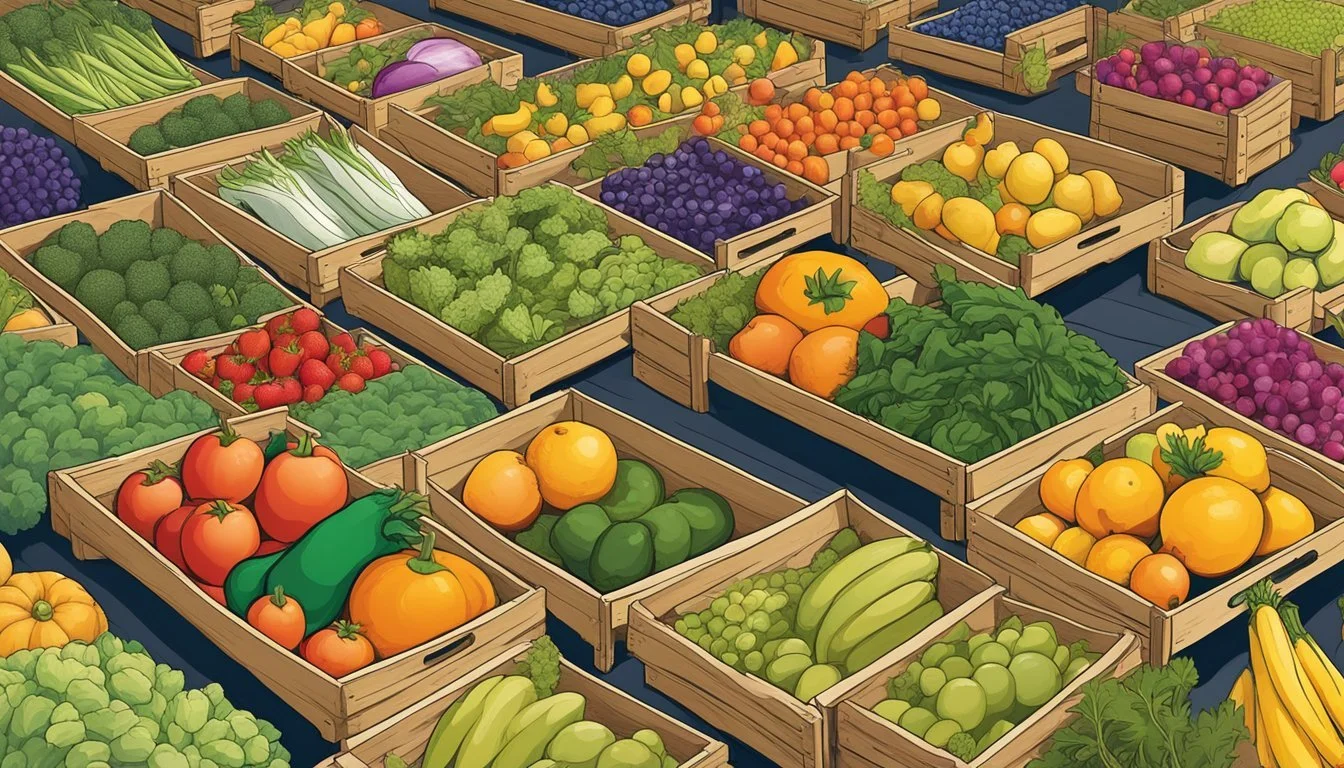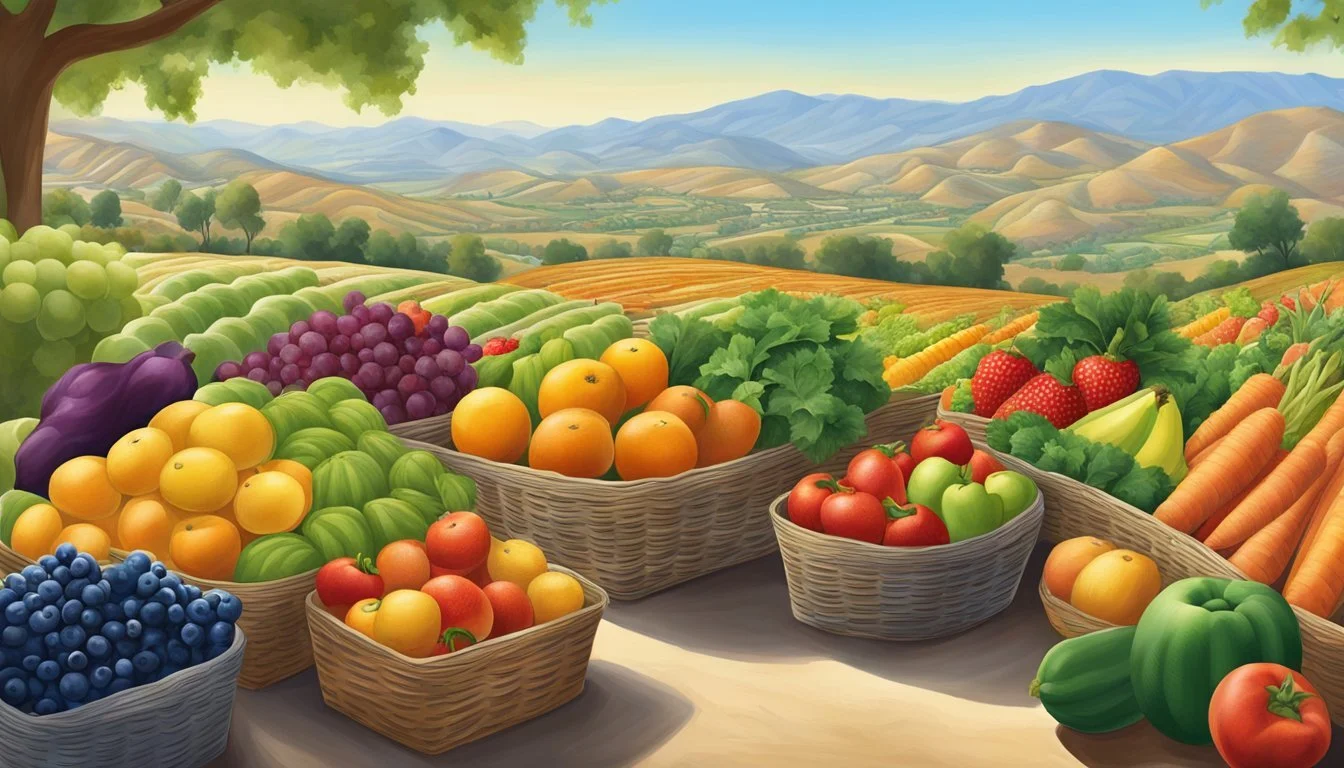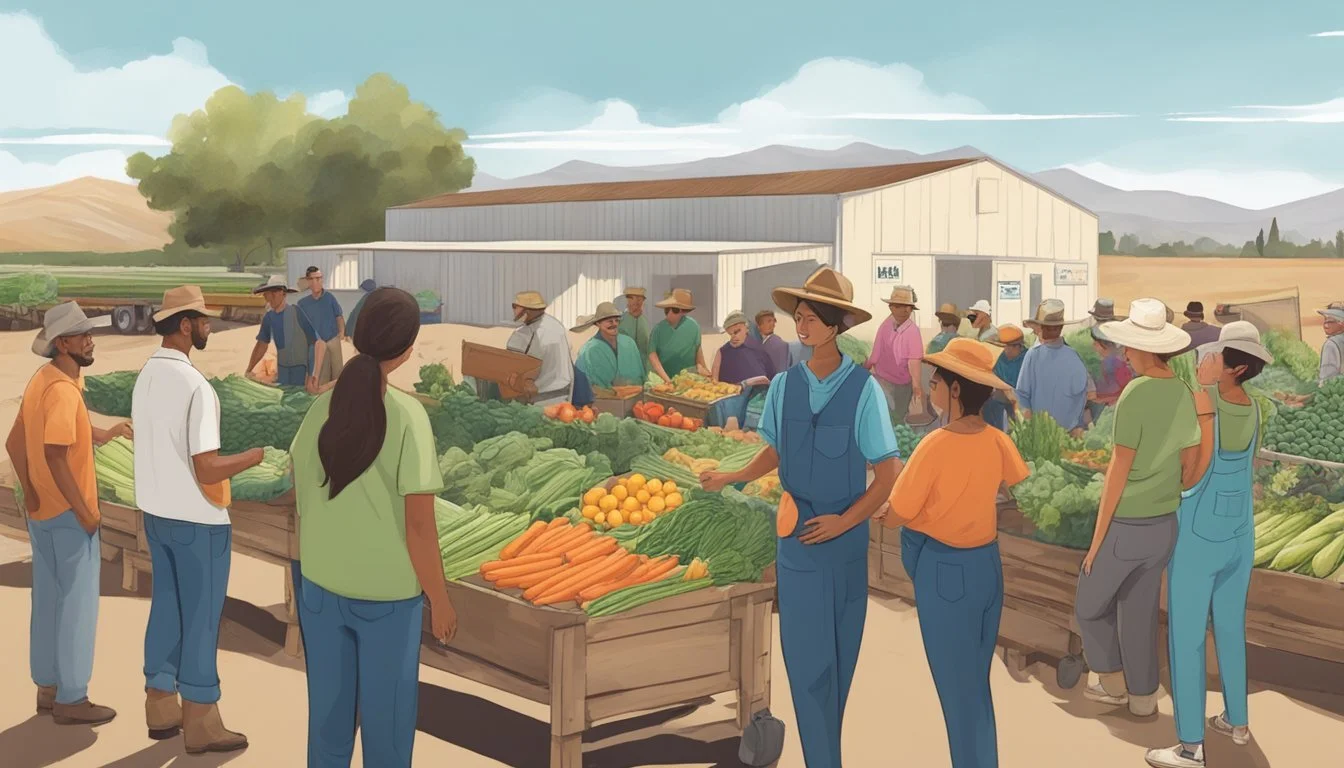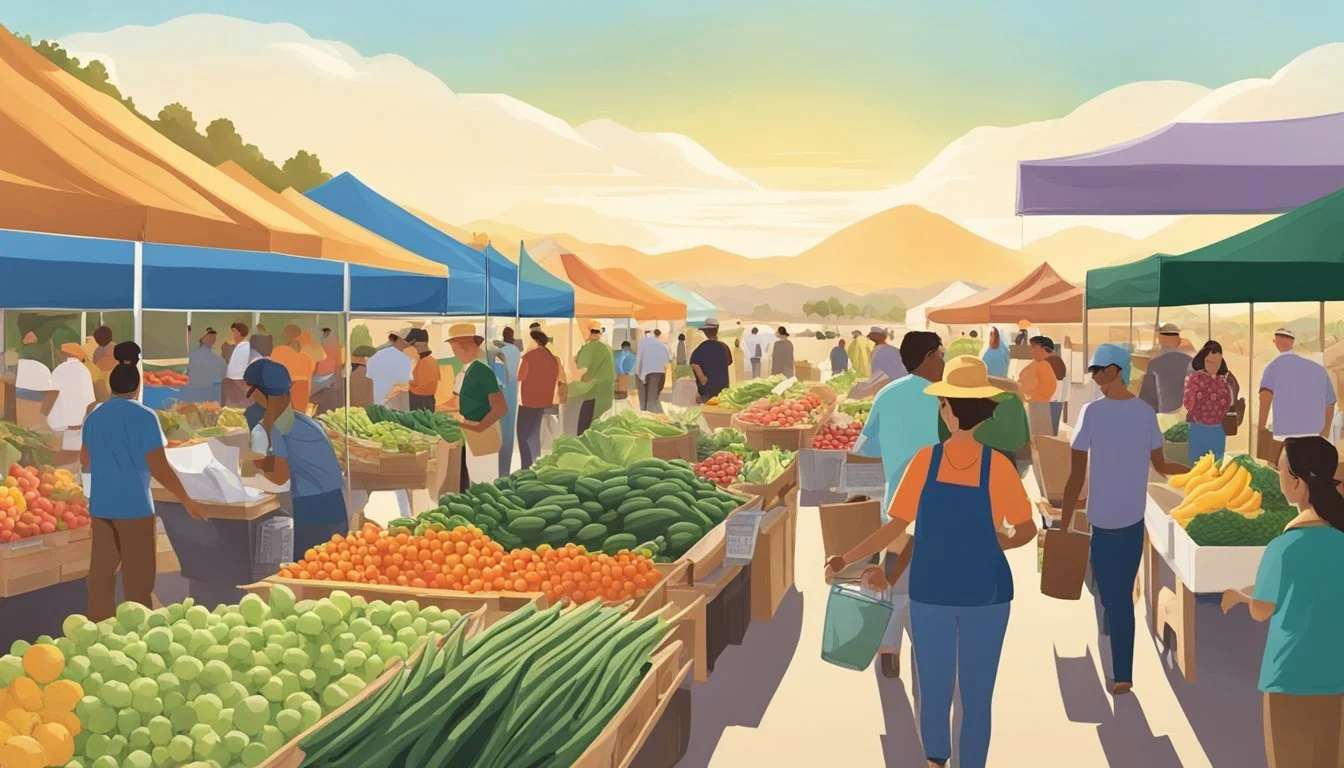Community Supported Agriculture (CSA) in Jurupa Valley, CA
A Guide to Local Produce and Farms
Community Supported Agriculture, commonly known as CSA, is a model that has seen significant growth in the agricultural landscape, connecting consumers and farmers more directly. In Jurupa Valley, California, this system supports local agriculture by allowing residents to purchase shares of a farm's harvest in advance. These shares, typically composed of a box of seasonal produce, provide members with regular distributions of fresh, locally grown food, fostering community relationships and promoting sustainable farming practices.
The CSA model in Jurupa Valley encourages an array of benefits, including fresher produce for consumers and a guaranteed market for farmers. It hinges on the idea of shared risk and reward; members pay up front for the entire season and receive a portion of the farm's harvest, understanding that they share in the bounty as well as the possibility of a lesser yield due to various farming challenges. This arrangement bolsters the local food system and often leads to more environmentally friendly farming methods, since farmers are accountable to their CSA members, who typically value ecological stewardship.
By participating in a CSA, Jurupa Valley residents not only secure a source of nutritious food but also contribute to the viability of local farms. This system encourages an understanding and appreciation of the seasonal rhythms of agriculture in Southern California. It represents more than a mere commercial transaction; it embodies a commitment to health, community, and the environment, linking the wellbeing of consumers directly with the health of their local farmland.
Overview of CSA in Jurupa Valley, CA
Community Supported Agriculture is an integral part of Jurupa Valley's commitment to sustainable food systems, boasting a history of growth and a variety of farms that contribute to the local economy.
History and Growth of CSA
In Jurupa Valley, the introduction of CSA programs dates back to the early adoption of these models in California. A steady increase over the years paralleled the statewide trend that echoed the consumers' desire for locally-grown produce. This agricultural model allowed community members to directly support local farms and reinforce economic stability in agriculture.
Current CSA Farms
Today, there are several established CSA farms in Juripa Valley operating to meet the needs of the community. These farms offer diverse produce selections and provide regular deliveries to members. Among these, the following CSA farms are currently active:
Farm A: Known for their variety of organic vegetables and fruits.
Farm B: Specializes in heirloom crops and offers educational farm visits.
Farm C: Provides a combination of produce and artisan-made goods.
Economic Viability in Jurupa Valley
The economic success of CSA farms in Jurupa Valley can be credited to the supportive local community that values fresh, sustainable agriculture. As part of the larger Central Valley agricultural context, these CSA farms contribute to:
Reducing dependency on nationwide food distribution chains.
Cultivating a closer relationship between consumer and producer.
Enhancing the resilience of local food systems against market volatility.
Overall, CSA operations in Jurupa Valley showcase a successful adaption of small-scale sustainable farming in a Californian setting, promoting health, community, and economic gains.
How CSA Works
Community Supported Agriculture in Jurupa Valley, CA, connects residents with local farms through a structured subscription service. This service allows members to purchase a share of the harvest, ensuring a steady supply of fresh produce throughout the growing season.
CSA Model and Structure
Community Supported Agriculture (CSA) operates on a simple principle: members pay in advance for a season's worth of produce, creating a financial backbone for the farmers. This upfront investment aids farmers in planning and mitigates some of the risks associated with agriculture. In Jurupa Valley, a traditional CSA model is popular, wherein farmers offer shares—pre-determined quantities of fresh produce—to the members regularly, usually on a weekly basis.
Membership and Subscription Details
Members secure their CSA subscription by purchasing a share before the harvest season begins. The cost of a share can vary depending on the farm's offerings and the length of the subscription period. Typically, subscriptions detail the volume of produce to be provided, with options for individual or family-sized shares. Some CSA programs allow for payment installments or provide sliding scale options to accommodate various income levels.
Weekly Shares and Deliveries
Each weekly share represents a portion of the farm's harvest and is delivered to a designated pick-up location or directly to the member's home. Shares commonly include a variety of vegetables, fruits, and herbs, with some farms also offering eggs, honey, or other farm products. The contents of a weekly share are based on what is seasonal and abundant on the farm, allowing members to enjoy the freshest local produce and diversify their diet in tune with the growing season.
Benefits of Joining a CSA
Joining a Community Supported Agriculture (CSA) program in Jurupa Valley offers distinct advantages for both consumers and farmers, fostering a supportive relationship that benefits the local community.
Advantages for Consumers
Consumers in Juripa Valley who participate in CSA programs enjoy fresh, seasonal produce that is sourced directly from local farms. By engaging in this model of agriculture, they receive a plethora of benefits:
Freshness and Quality: Members receive high-quality, nutritious produce that is often picked within a day of delivery, ensuring peak freshness and flavor.
Support Local Economy: By joining a CSA, consumers help sustain local farmers financially, contributing to the local economy and preserving agricultural land.
Education on Food Sources: CSA members gain insight into the production of their food, which can increase appreciation and encourage healthier eating habits.
Environmental Impact: Supporting CSAs reduces the carbon footprint associated with long-distance transportation of food.
Advantages for Farmers
Farmers in Jurupa Valley benefit from the CSA model, which provides them with a reliable market for their products:
Financial Security: Upfront payment for CSA shares helps farmers with initial production costs and provides financial stability.
Marketing and Distribution Efficiencies: Farmers save on marketing efforts and have a guaranteed outlet for their products, allowing them to focus more on farming practices.
Community Connection: Farmers build strong relationships with consumers, which can enhance their reputation and lead to customer loyalty.
Risk Mitigation: Shareholders share the risks of farming, such as poor harvests due to weather conditions, which can lead to a more sustainable operation.
Challenges and Considerations
In Jurupa Valley, CA, Community Supported Agriculture (CSA) is a model that hinges on cooperation and understanding between local producers and consumers. It faces unique challenges that necessitate particular consideration by all stakeholders involved.
Understanding Shared Risks
Risks in CSA are inherent and shared between farmers and members. For farmers in Jurupa Valley, these risks could include unforeseen weather events that affect crop yields or pest infestations that can reduce the quality and quantity of the produce.
Weather Variability: An unpredictable climate can dramatically alter the success of a harvest.
Pest Issues: Pests pose a threat, often variable and unexpected, requiring proactive and sometimes innovative management.
It is essential that members acknowledge these risks upfront as part of the CSA model, contributing to a stronger, more resilient local food system.
Common Questions and Tips for Members
Prospective and current members typically have many questions regarding their CSA memberships. They seek tips on how to maximize the benefits of their participation and support the agricultural process effectively.
How to Utilize the Full Share: Members can ask for recipes or attend workshops to learn how to best use their seasonal produce.
Supporting the Farm Beyond Subscriptions: Members can inquire about volunteering opportunities or offer support during community events.
Jurupa Valley's CSA members can enhance their experience by staying informed and involved, thereby directly contributing to the sustainability of the CSA model.
CSA's Role in Sustainability
Community Supported Agriculture (CSA) in Jurupa Valley, CA, exemplifies a sustainable model that supports local agriculture by incorporating both environmental consideration and community engagement.
Community and Environmental Impact
A CSA is instrumental in reducing carbon footprint by minimizing the distance food travels, thereby cutting down transportation emissions. In Jurupa Valley, CSA members consume produce that's distributed directly from nearby farms, ensuring fewer food miles and a smaller carbon footprint. Additionally, these local farming operations frequently employ organic methods which promote biodiversity and soil health.
Carbon Footprint Reduction: Less transportation needed.
Local Food Systems: Enhance community resilience.
Promoting Sustainable Agriculture
Sustainable agriculture is at the heart of CSA. In Jurupa Valley, farmers who adopt the CSA model often follow sustainable farming practices like crop rotation, reduced use of artificial inputs, and conservation of soil and water.
Crop Rotation: This practice helps in maintaining soil fertility and health.
Minimal Use of Artificial Inputs: Leads to fewer environmental pollutants.
Water Conservation: Ensures efficient use of water resources.
By supporting CSAs, residents of Jurupa Valley directly contribute to sustainable agriculture, which, in turn, results in environmental benefits and community well-being.
Connecting with Local CSAs
In Jurupa Valley, CA, residents interested in fresh, locally-grown produce can significantly benefit from joining a Community Supported Agriculture (CSA) program. CSAs forge a direct link between local farmers and community members, ensuring support for regional agriculture and providing members with a share of the harvest throughout the growing season.
How to Find and Choose a CSA
To locate a CSA in Jurupa Valley, interested individuals can start by consulting the CSA Innovation Network or local directory listings. The decision to join a specific CSA should be informed by factors such as the types of products offered, whether the produce is organic, the pick-up locations, and the flexibility of share sizes. Prospective members can consider the following steps:
Research Online: Utilize online platforms and agriculture directories.
Attend Local Farmer's Markets: Engage with farmers directly to learn about their CSA offerings.
Ask for Referrals: Current CSA members can provide valuable insights.
Visit Farms: Evaluate farming practices and establish a connection with the farmers.
Building Community through CSA Partnerships
Joining a CSA is more than just a transaction; it's an investment in local agriculture and the Jurupa Valley community. Membership in a CSA encourages cooperation and mutual support, enhancing the relationship between consumers and growers. Community benefits include:
Supporting Local Farmers: Direct contributions to local farmers' success and sustainability.
Participating in Events: Some CSAs hold community events, allowing members to engage with one another and deepen their understanding of farming practices.
In summary, connecting with a CSA in Jurupa Valley not only offers fresh produce to community members but also nurtures local agriculture and strengthens community bonds.
CSA Beyond Produce
Community Supported Agriculture in Jurupa Valley extends well beyond the traditional offerings of fruits and vegetables. Subscribers can expect a diverse array of products including, but not limited to, fresh eggs, various meats, and unique agritourism experiences.
Inclusion of Eggs, Meat, and Other Products
CSAs in Jurupa Valley often provide their members with a varied selection of farm-fresh products. These might include:
Eggs: Often sourced from free-range chickens, offering a staple high in protein.
Meat: Selections can range from grass-fed beef to pasture-raised pork and lamb.
Additionally, many CSAs may include:
Honey
Dairy products like milk and cheese
Specialty items such as homemade jams and artisan breads
It is essential for members to understand that these items are subject to availability and seasonal changes.
CSA and Agritourism Opportunities
Agritourism stands as a significant component of the CSA experience in Jurupa Valley, inviting members to engage with farming activities firsthand. Opportunities may include:
Farm Tours: Educational journeys through the farm's operations.
Harvest Events: Where members can participate in the picking and gathering of their food.
Workshops: Designed to teach skills like canning, cheese-making, or organic gardening.
Through these activities, members gain a deeper appreciation and connection to the sources of their food, fostering a stronger community bond.
CSA Marketing and Growth Strategies
Community Supported Agriculture in Jurupa Valley can leverage targeted marketing and strategic growth initiatives to ensure both longevity and profitability. By harnessing direct marketing techniques and CSA organizers, farmers can effectively expand their customer base and maintain a robust, sustainable operation.
Direct Marketing Techniques
Direct marketing remains a cornerstone practice for CSA in Jurupa Valley, utilizing personal relationships to retain members and attract new ones. Tactics include engagement at local farmers markets, where farmers can showcase their produce and CSA program benefits directly to potential customers. They may also implement referral programs, rewarding existing CSA members that bring in new participants, creating a grassroots boost in membership.
Email campaigns, social media outreach, and community events offer additional platforms for direct interaction. Farmers should prioritize these channels to highlight their CSA's unique qualities, share testimonials, and reinforce their brand directly with the consumer.
Using CSA Organizers for Expansion
CSA organizers play a crucial role in the growth of Community Supported Agriculture. They bridge the gap between farmers and the local community. By coalescing groups of consumers, organizers can drive larger subscription numbers for the CSA, which helps in scaling up production and income.
Organizers might collaborate with local businesses or community centers to establish drop-off points, which contributes to community engagement and simplifies distribution. Furthermore, organizers can manage the recruitment and retention processes, fine-tuning the marketing strategy to fit regional needs and demographic targets.
In closing, applying these strategies with a focus on clear communication and community involvement will help CSAs in Jurupa Valley flourish.
Resources and Support for CSA Members and Farmers
Community Supported Agriculture in Jurupa Valley, CA, benefits from a variety of comprehensive resources and support mechanisms. These are essential for both new and existing CSA members and farmers, offering educational tools, networking opportunities, and government-backed research to bolster the CSA model's success.
Educational Resources and Networking
CSA Innovation Network: A pivotal resource for farmers, the CSA Innovation Network facilitates information sharing and provides educational tools. They actively promote best practices for CSA operations, connecting farmers with a wealth of knowledge on how to start and sustain their CSA programs.
Workshops and Training Sessions: Regularly held events enable farmers to acquire new skills and stay informed about the latest agricultural trends.
Networking Opportunities: Peer-to-peer networking is fostered through events and an online platform, allowing farmers to share experiences and collaborate.
Governmental Support and Research
U.S. Department of Agriculture (USDA): The USDA offers extensive support to CSA members and farmers through research and statistical data collection. This information guides policy development and resources allocation to enhance direct-to-consumer sales models, including CSA.
Research Funding: Grants are available for CSA-specific agricultural research, aiding in the development of more efficient and sustainable farming practices.
Statistical Data: The compilation of CSA data assists in understanding market trends, consumer preferences, and the economic impact of CSAs, including sales figures and operational demographics.
These supports empower farmers in Jurupa Valley to effectively manage their CSAs and secure a stable market for their produce, ensuring that community members receive fresh, locally-grown food directly from the source.
Demographics and Diversity in CSA
Community Supported Agriculture (CSA) in Jurupa Valley, CA, reflects a broad spectrum of participants and practices, emphasizing the roles of women in farming and the enhancement of agrobiodiversity. Jurupa Valley's CSAs are carving a niche for inclusivity and ecological mindfulness within the local agricultural community.
Women in CSA Farming
In Jurupa Valley, women are pivotal to the CSA landscape. They not only contribute to the farming population but also often take leading roles in the operation and management of CSA farms. These farms serve as platforms for empowerment and leadership for women in the agricultural sector. The presence of women is influential as they bring diverse perspectives to farming practices, community engagement, and sustainable agriculture leadership.
Increasing Agrobiodiversity with CSA
CSA models in Jurupa Valley are instrumental in enhancing agrobiodiversity. By fostering a direct farmer-consumer relationship, CSAs encourage the cultivation of a wider variety of crops. This is particularly beneficial for heirloom and non-commercial varieties that conventional agriculture might overlook. Such efforts in CSA farming help to conserve biodiversity and improve resilience against pests and diseases, contributing significantly to ecological health in agriculture.
Future of CSA
Community Supported Agriculture (CSA) in Jurupa Valley stands on the cusp of significant changes, poised to integrate innovative practices and respond to emerging economic trends.
Innovation and CSA
Jurupa Valley's CSAs are tapping into the CSA Innovation Network to enhance their operations. This network facilitates the exchange of groundbreaking ideas and technologies, such as incorporating precision agriculture to optimize resource usage and improve yields. Data-driven cultivation methods are replacing traditional ones, allowing farmers to make informed decisions that lead to more sustainable practices. The introduction of smart greenhouse systems is one such innovation, enabling year-round production and local supply stability.
Economic Trends and Predictions
The economic viability of CSA models is increasingly under the spotlight, as consumer behavior and market dynamics shift. Subscription-based revenue models offer farmers more predictable income streams, mitigating some of the financial risks associated with traditional farming. Here are the projected economic trends impacting CSAs:
Demand Growth: A continued increase in demand for locally-sourced and sustainably-grown produce is expected.
Production Costs: Innovations have the potential to reduce production costs, enhancing the economic attractiveness of CSAs.
Market Penetration: CSAs may potentially expand their market share by targeting price-competitive segments against traditional agriculture.
In conclusion, CSA in Jurupa Valley appears to be advancing towards a future where innovation and favorable economic trends pave the way for a more sustainable and prosperous agricultural sector.








